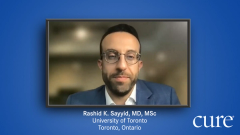
Prostate Cancer: Treatment Decision-Making and the Role of Guidelines
A genitourinary oncologist provides insights on the treatment decision-making process and the roles of guidelines for prostate cancer.
Episodes in this series

How are treatment decisions generally made?
Alicia Morgans, MD, MPH: Treatment decisions for localized prostate cancer that has not spread out of the prostate are usually made on the basis of using guidelines, which are essentially consensus recommendations that are put together by experienced physicians and clinicians from different areas of prostate cancer care, including urology, medical oncology, radiation oncology, and sometimes statisticians help us interpret the data from clinical trials that inform those guidelines. Guidelines are best practices, and we use them as physicians to make sure that people have the same treatment every time and that everybody gets the best quality care.
When we make these decisions for treatment, when the prostate cancer is all inside the prostate, we typically think about things like surveillance or monitoring and not doing an active treatment against the prostate cancer for people who have low-risk disease. This decision is made through shared decision-making with the patient, the patient’s family, and the clinical team. When people feel comfortable with that monitoring process, physicians usually feel quite comfortable with it because it can help avoid the complications from therapies like radiation or surgery and help patients who never need to get treated not have symptoms and adverse effects related to therapy.
We use shared decision-making even when the cancer is a little bit more advanced, and we’re thinking about things like radiation and surgery as options for therapy. And sometimes these decisions get pretty complicated, especially when we have to think about adding in medicines that can cause their own adverse effects and are frequently used with radiation. And these conversations are shared between the patient, the patient’s family and loved ones, and the clinical team. It can take some time, even days to weeks, to make the right choice with the patient. But that’s normal. And as long as the cancer is not extremely aggressive, it is important and recommended that people do take the time that they need to get the right treatment for them. Ultimately, thinking about the guidelines, thinking about the specifics of that individual person in terms of their wishes for what life will look like after their treatment, their requirements in terms of their other medical conditions, their prior surgeries, and their age are all considered. That shared decision-making process can be a great way to help an individual find the right treatment for them.
Transcript is AI-generated and edited for clarity and readability.








